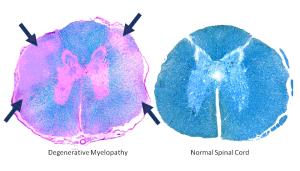

MedFriendly®


Myelopathy
Myelopathy usually refers to damage of the spinal
cord. There are three main types. The first is caused
by trauma (such as a car accident) and is commonly
referred to as a spinal cord injury (SCI). The second
is inflammation of the spinal cord, which is known as
myelitis. The third is damage caused by interruption of
the blood supply (and consequently the oxygen
supply) of the spinal cord such as anterior myelopathy
and posterior myelopathy.
Myelopathy (left) of the spinal cord vs.
normal spinal cord (right).
FEATURED BOOK: Clinical Anatomy of the Spine
Anterior myelopathy refers to premature death of tissue in the anterior (front) spinal
artery and/or its branches due to a decrease or loss of oxygen to this region. Likewise,
posterior myelopathy refers to premature death of tissue in the posterior (back) spinal
arteries and/or its branches due to a decrease or loss of oxygen to this region. Patients
motor neurons. Upper motor neurons are nerve cells in the motor cortex (an area in the
front part of the brain that helps control motor functioning) that compose two types of
nerve tracts (paths), one of which connects to the spinal cord. These signs and
symptoms include muscle weakness, poor control of movements, overactive reflexes,
spasticity (involuntary muscle contractions), and the Babinski sign. In the Babinski sign,
the big toe turns upward when the bottom of foot is stimulated with a blunt instrument.
Upper motor neuron signs can be present on both sides of the body and can occur
immediately after spinal cord damage or take up to weeks to present. Problems
controlling the bowel and bladder can also occur in myelopathy.
"Where Medical Information is Easy to Understand"™
Myelopathy of the spine can be detected with magnetic resonance
imaging (MRI). MRI scans produce extremely detailed pictures of the
inside of the body by using very powerful magnets and computer
technology. Another technique used to diagnose myelopathy and
assess the location and severity of it that uses magnetic fields is
transcranial magnetic stimulation (TMS) through a measure known as
central motor conduction time. This metric assesses the speed by
which nerve impulses travel from the cerebral cortex (outermost part
of the brain) to different areas in the spinal cord. Myelopathy also
refers to a disease of the bone marrow or blood cells that come from
bone marrow. Bone marrow is a tissue that fills the openings of bones.
The word "myelopathy" comes from the Greek word "myelos," meaning "marrow," and the word "pathos,"
meaning "suffering." Put the two words together and you get "suffering of the marrow," where marrow
refers to the spine.















